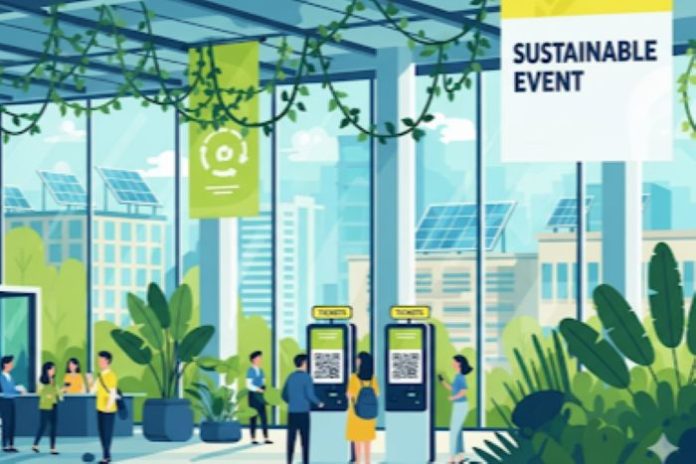In a nutshell: The events industry generates nearly 10% of global emissions, but greener choices can reduce this impact. Sustainable steps include cutting waste, offering hybrid options, and choosing clean-energy venues. Major events like the Paris 2024 Olympics and Salesforce Dreamforce show that eco-friendly practices can scale. Looking ahead, AI, blockchain ticketing, and carbon tracking apps will drive the future of sustainable event planning.
Events are powerful. They bring people together to share knowledge, celebrate milestones, or enjoy performances. Yet they also leave behind waste and emissions.
The events industry is linked to almost 10% of global greenhouse gas emissions. A single conference guest can create nearly 2 kilograms of waste every day.
This is why sustainable event planning is no longer optional. It is a responsibility. With smart choices, planners can reduce harm to the planet while improving the guest experience. A simple first step is to go paperless.
Using tools like Ticket Generator for e-tickets or QR Codes for schedules saves paper and reduces printing costs.
Table of contents
- A. Why Sustainable Event Planning Matters?
- B. Practical Strategies for Greener Events
- C. Case Studies: Green Events in Action
- D. Social Side of Sustainability
- E. Going Paperless with QR Codes and Ticket Generator
- F. Future Trends in Sustainable Events
- G. FAQs about Sustainable Event Planning
- Conclusion: Every Step Counts
A. Why Sustainable Event Planning Matters?
For corporate planners, sustainable events enhance brand reputation and meet growing stakeholder expectations. Showing leadership in green practices can attract sponsors and partners who prioritize sustainability.
For nonprofit organizers, eco-friendly events align with mission-driven values and set an example for the community. And for general audiences, attending a greener event means a guilt-free experience that resonates with personal environmental concerns.
Sustainable event planning is about more than token gestures; it means rethinking every aspect of an event to minimize harm and even create positive impact.
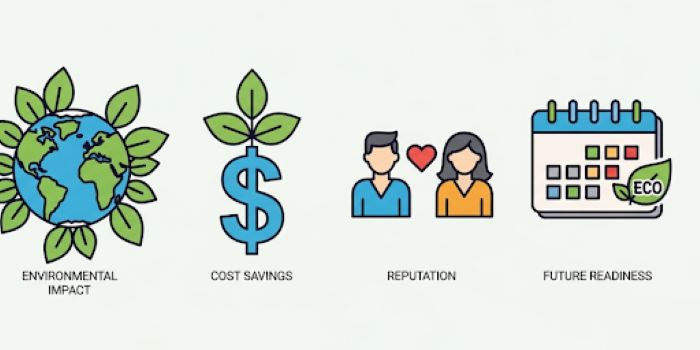
This includes reducing waste, conserving energy, sourcing responsibly, and ensuring the event benefits the local community. By taking these steps, event organizers can significantly shrink the environmental footprint of their events while still delivering memorable experiences.
In fact, many forward-thinking planners view sustainability as a must-have, not a nice-to-have, in modern event design.
They recognize that eco-friendly events can boost attendee satisfaction, drive innovation, and build goodwill that lasts long after the lights go down.
B. Practical Strategies for Greener Events
Here are proven ways to make events eco-friendly.
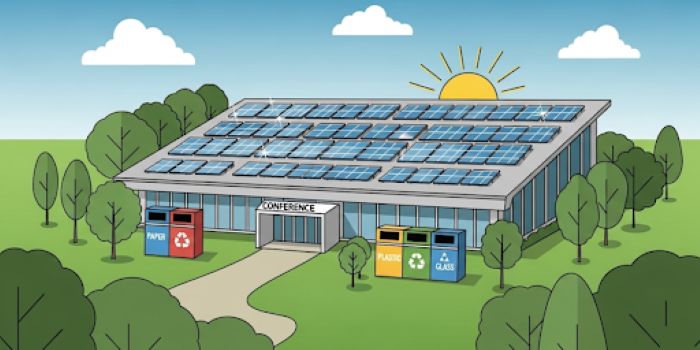
1. Set Clear Goals
The foundation of any sustainable event planning is clear, measurable objectives. Without them, “going green” risks becoming vague or performative.
Event planners should define specific targets early in the process, such as reducing landfill waste by 70%, cutting food leftovers by half, or achieving complete elimination of single-use plastics.
These goals should be aligned with organizational values and stakeholder expectations, then shared with all vendors, partners, and staff to ensure accountability.
Progress can be monitored through checklists, digital dashboards, or sustainability audits conducted during and after the event.
Establishing metrics upfront not only guides decision-making but also provides concrete data for post-event reporting.
2. Choose a Sustainable Venue
The venue choice has an outsized impact on an event’s environmental footprint. Planners should prioritize locations that demonstrate a commitment to sustainability through renewable energy use, efficient HVAC and lighting systems, and water conservation infrastructure.
Look for certifications such as LEED, ISO 20121, or Green Key, which indicate verified green practices.
Accessibility also matters: venues close to hotels, airports, and public transit reduce the need for carbon-intensive transport.
Additionally, confirm whether the facility has robust waste diversion systems like on-site composting, recycling bins, and vendor policies that support low-impact operations.
A venue audit or checklist can help verify these claims rather than relying solely on marketing brochures.
3. Reduce Travel and Add Virtual Options
Transportation often accounts for the majority of an event’s emissions, sometimes exceeding 70–80% of its total footprint.
To mitigate this, planners can localize events by selecting central destinations or hosting multiple regional editions to minimize long-haul travel.
Offering hybrid or virtual attendance options is increasingly common and enables international participants to join without the carbon cost of flights.
For in-person guests, sustainable practices include arranging shuttle services, facilitating carpools, and incentivizing train or bus travel through discounts or perks.
Some events even gamify the process by recognizing attendees who arrive via sustainable transport.
For unavoidable emissions from air travel, organizers should calculate the footprint and purchase third-party verified carbon offsets, ensuring accountability and transparency.
4. Cut Waste at the Source
Waste management is one of the most visible areas where sustainable practices make an immediate impact.
The first priority should be waste prevention, such as replacing printed brochures, schedules, and signage with digital alternatives delivered via mobile apps or QR Codes.
Event ticketing should also go fully digital, eliminating the need for paper passes. Where physical materials are unavoidable, they should be recyclable or compostable.
Waste stations, clearly labeled for landfill, recycling, and compost, should be distributed in high-traffic areas to encourage proper sorting.
Partnerships with local charities are invaluable for redirecting surplus food, supplies, or decor away from landfills.
Events that implement these measures consistently report reductions of 60% or more in total waste generation.
5. Plan Sustainable Catering
Food and beverage operations can represent a large share of an event’s emissions, particularly due to meat-heavy menus and excessive packaging.
A shift toward plant-forward catering, where vegetarian and vegan dishes are emphasized, has proven to significantly reduce both carbon output and water usage.
Planners should work with caterers who source seasonal, locally grown produce, minimizing the environmental impact of long supply chains.
Water refill stations should replace bottled water, and condiments or drinks should be served in bulk rather than in single-use containers.
To handle leftovers responsibly, establish agreements with food recovery organizations that can safely distribute surplus meals to community shelters or food banks.
This not only reduces waste but also strengthens local impact.
6. Eco-friendly Swag and Décor
Promotional giveaways and decorations are often overlooked contributors to waste. Planners should avoid cheap, disposable items that quickly end up in landfills and instead choose practical, sustainable alternatives.
Popular eco-friendly gifts include reusable bottles, bamboo notebooks, digital gift cards, or even seed paper kits that reinforce the green message.
Décor can also be approached sustainably by opting for digital signage in place of printed banners and by renting or reusing stage elements rather than purchasing items destined for single use.
Such choices not only cut down on waste but also improve the event’s brand image by signaling innovation and responsibility.
7. Save Energy for Sustainable Event Planning
Events are resource-intensive, consuming large amounts of electricity and, in some cases, water.
To reduce this load, planners should prioritize venues powered by renewable energy and equipped with efficient LED lighting, sound systems, and smart HVAC controls.
For outdoor or temporary events, solar-powered or biofuel generators can replace diesel alternatives.
Beyond reducing consumption, organizers can further demonstrate commitment by offsetting remaining emissions through verified carbon projects, such as reforestation, renewable energy development, or community clean-energy programs.
Reporting these offsets transparently builds trust and shows attendees that sustainability efforts extend beyond the event itself.
C. Case Studies: Green Events in Action
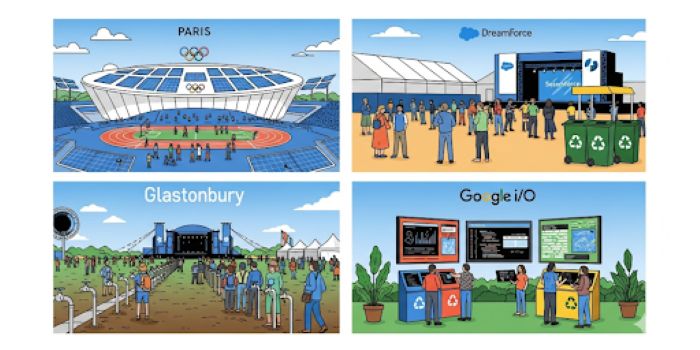
1. Paris 2024 Olympics
The Paris 2024 Olympics were widely regarded as a benchmark in sustainable mega-events. Roughly 95% of the venues used were either pre-existing or temporary structures, which dramatically reduced construction-related emissions and waste.
The Games were also powered almost entirely by renewable energy sources, from solar to wind, minimizing reliance on fossil fuels.
As a result, the overall carbon footprint was cut nearly in half compared to the previous Olympic Games.
This case demonstrates that even global-scale sporting spectacles with millions of spectators can implement meaningful green measures when sustainability is built into planning from the start.
2. Salesforce Dreamforce (San Francisco)
Dreamforce, Salesforce’s annual tech conference in San Francisco, illustrates how a corporate event can balance scale with sustainability. The organizers set a bold target of achieving zero waste.
To reach this, they used compostable serveware across all food services, eliminated single-use plastics, and collaborated with local nonprofits to donate excess meals to those in need.
Their waste diversion efforts were so effective that the event consistently diverts the majority of its refuse away from landfills.
Dreamforce shows how corporate events can align brand values with environmental action while creating positive community impact.
3. South by Southwest (Austin)
South by Southwest (SXSW), a massive cultural and tech festival, has steadily integrated sustainability into its operations.
In recent years, the festival shifted to digital ticketing systems, reducing paper waste significantly across tens of thousands of attendees.
Austin’s city-wide recycling infrastructure was leveraged to ensure waste from venues was diverted responsibly, and catering relied heavily on partnerships with local farmers, reducing food miles and supporting the regional economy.
SXSW demonstrates how creative and cultural gatherings can model sustainability while still delivering a dynamic and immersive experience for attendees.
4. COP Climate Conferences
As global summits dedicated to tackling climate change, the COP (Conference of the Parties) events have adapted their own formats to reflect environmental responsibility.
Recent COP conferences have adopted hybrid participation models, allowing delegates to join remotely and thereby reducing travel emissions.
Digital tickets and program guides have replaced paper-heavy alternatives, and sourcing local suppliers has cut down both costs and transportation impacts.
While these conferences still carry significant footprints, the shift to greener logistics shows that even high-profile political events can practice what they preach by adopting practical sustainability measures.
5. Glastonbury Festival (UK)
The Glastonbury Festival, one of the world’s most iconic music events, has been a pioneer in large-scale sustainable practices.
The festival banned single-use plastic bottles, saving hundreds of thousands of items from entering waste streams each year.
Composting toilets have become the standard across the grounds, significantly reducing water use and managing waste more responsibly.
In addition, the stages are increasingly powered by renewable energy solutions such as solar panels and biofuel generators. Glastonbury proves that festivals with enormous attendance numbers can successfully embed sustainability into their culture and operations.
6. Google I/O (California)
Google’s annual developer conference, Google I/O, provides a tech-centric example of sustainable event planning.
By moving toward a hybrid format, the event reduced the volume of international travel required for participation.
The organizers also eliminated traditional plastic conference badges, replacing them with digital equivalents that attendees could access on their devices.
This not only reduced waste but also simplified check-in and attendee management.
Google I/O highlights how technology companies can use their own innovations to model environmentally conscious event design.
D. Social Side of Sustainability

Sustainability is not only about the environment. It also includes people and communities:
1. Accessibility
Sustainability extends beyond environmental concerns to include inclusivity and accessibility. Hybrid and virtual event formats allow participants to engage without long-distance travel, lowering emissions while opening the door for people who may face mobility, financial, or time constraints.
On-site, venues should be equipped with ramps, elevators, and wide pathways to ensure equal access for attendees with disabilities.
Incorporating closed captioning, sign language interpretation, and language translation tools makes sessions more inclusive.
Even catering plays a role; providing halal, kosher, vegetarian, vegan, and allergy-sensitive meal options ensures that all guests feel considered.
By prioritizing accessibility, events not only reduce environmental impact through remote participation but also embody the broader principle of sustainability: leaving no one behind.
2. Community Support
Sustainable events thrive when they create value for the local community.
One effective approach is to source goods and services from local vendors, such as caterers, farmers, printers, and artisans, thereby reducing transportation emissions while stimulating the regional economy.
Beyond procurement, organizers can arrange for leftover food, signage, and materials to be donated to local charities or repurposed for schools, shelters, or recycling projects.
Some events even recruit volunteers from community groups, offering them visibility and networking opportunities in return.
This not only reduces waste but also strengthens the connection between the event and its host community, ensuring that the benefits of the gathering extend well beyond its attendees.
3. Education
Engaging guests directly in sustainability efforts amplifies impact. Rather than keeping eco-friendly initiatives behind the scenes, organizers should share their goals with attendees and invite them to participate.
Pre-event communications can highlight practices such as bringing reusable bottles, using public transit, or downloading digital programs instead of expecting printed handouts.
On-site, clear signage at recycling stations, sustainability pledge walls, or real-time dashboards showing energy savings can reinforce these efforts.
When participants feel like partners in the process, they are more likely to act responsibly and even carry these behaviors into their daily lives.
This sense of shared responsibility transforms sustainability from a logistical detail into a core part of the event’s culture, boosting engagement and long-term impact.
E. Going Paperless with QR Codes and Ticket Generator
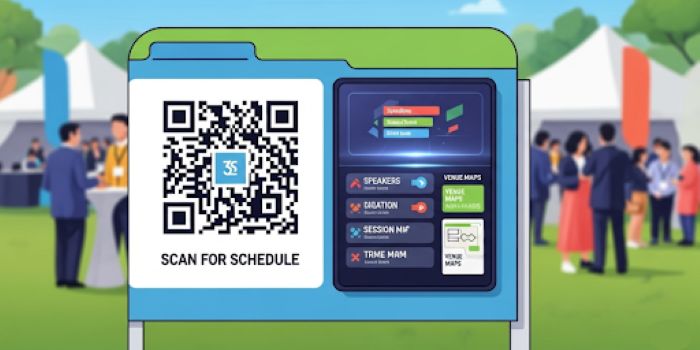
Digital tools make it simple to plan greener events. They cut down on paper, save money, and improve the guest experience.
1. E-tickets with Ticket Generator
Instead of printing thousands of paper tickets, organizers can send e-tickets by email. Each ticket includes a unique QR Code that is scanned at the gate for quick and secure check-in. This makes entry faster, reduces fraud, and removes the need for paper tickets altogether. Organizers also gain real-time data on attendance.
2. QR Codes for Event Information
Programs, schedules, and menus often fill dozens of pages. By placing QR Codes on signs, digital screens, or badges, guests can access all of this information with a simple scan. If details change, the linked page can be updated instantly without reprinting.
3. Contactless Sharing
Networking usually means exchanging stacks of business cards and brochures. With QR Codes printed on badges, guests can share profiles, websites, or digital cards on the spot. This eliminates waste and creates a modern, seamless way to connect.
Together, these solutions replace paper-heavy systems with smart, digital processes. The result is a more sustainable event that is easier to manage and more enjoyable for attendees.
Table: Quick wins for sustainable events
| Area | Traditional way | Green alternative | Impact |
| Tickets | Printed tickets and badges | E-tickets via Ticket Generator | Saves paper, reduces fraud |
| Programs | Printed brochures | Mobile apps or QR Codes | Cuts printing, faster updates |
| Food | Meat-heavy menus, bottled water | Plant-based meals, refill taps | Lower emissions, less waste |
| Décor and swag | Single-use décor, plastic gifts | Reusable décor, eco gifts | Less trash, better branding |
| Travel | Long-distance flights | Hybrid or local events | Cuts carbon footprint |
F. Future Trends in Sustainable Events

The future of green events looks promising:
1. AI-Powered Planning
Artificial intelligence is emerging as a valuable tool for event sustainability.
It can analyze data to recommend greener vendors, optimize transportation routes to reduce emissions, and even predict waste generation so planners can adjust catering or resource allocation in advance.
2. Blockchain Ticketing
Blockchain technology offers secure, tamper-proof digital tickets that eliminate the need for printing.
Beyond reducing paper use, blockchain can track the entire lifecycle of a ticket, cutting fraud and providing better accountability for attendance data.
3. Carbon Tracking Apps
Mobile apps now allow attendees to monitor the carbon impact of their travel and activities in real time.
Many also provide options to purchase verified offsets directly, helping individuals take responsibility while raising awareness about personal footprints.
4. Carbon-Neutral Pledges
More companies are committing to hosting 100% carbon-neutral events by 2030.
Some are already meeting this goal by purchasing renewable energy credits, investing in offsets, and working exclusively with eco-certified venues.
5. Virtual and Augmented Reality
Immersive technologies like VR and AR can replicate the experience of attending in person, making hybrid or fully virtual formats more engaging.
This reduces the need for long-distance travel while still delivering rich, interactive experiences.
G. FAQs about Sustainable Event Planning

1. Is sustainability too costly for small events?
No. Digital tools often save money. Reusable décor and cutlery reduce costs over time. Even small steps make a big difference.
2. Do guests care about green practices?
Yes. Surveys show most attendees value eco-conscious events. Many avoid events that ignore sustainability.
3. What is the easiest first step?
Go paperless. Switch to e-tickets and digital schedules. It is simple, low-cost, and impactful.
4. Can hybrid events really help?
Yes. Allowing remote attendance reduces travel emissions and opens the event to more people.
5. How do I measure success?
Track waste diverted from landfills, emissions saved, or the percentage of attendees using public transport. Share these numbers with stakeholders.
6. What if vendors are not eco-friendly?
Set clear requirements in contracts. Choose vendors who align with your sustainability goals.
7. How do I involve guests in sustainability?
Give clear instructions. Provide recycling stations, promote reusable bottles, and run awareness campaigns during the event.
8. Can sponsorships support sustainability?
Yes. Many brands want to be linked with eco-conscious practices. Pitch green efforts as part of your sponsorship package.
9. Is carbon offsetting enough?
Offsets help, but should not replace real reductions. First reduce waste and emissions, then offset what remains.
Conclusion: Every Step Counts
Sustainable event planning is about making better choices, one decision at a time. Pick venues with clean energy. Reduce travel. Cut waste. Serve greener food.
Use tools like Ticket Generator and QR Codes to go paperless.
Small actions add up. Switching to digital tickets or refill stations can save tons of waste. Guests notice these efforts and value them. Each event becomes a chance to do better than the last.
By planning events that are memorable and eco-friendly, you deliver success without leaving a heavy footprint. That is the kind of impact worth celebrating.



